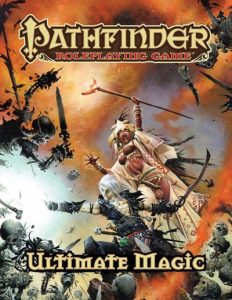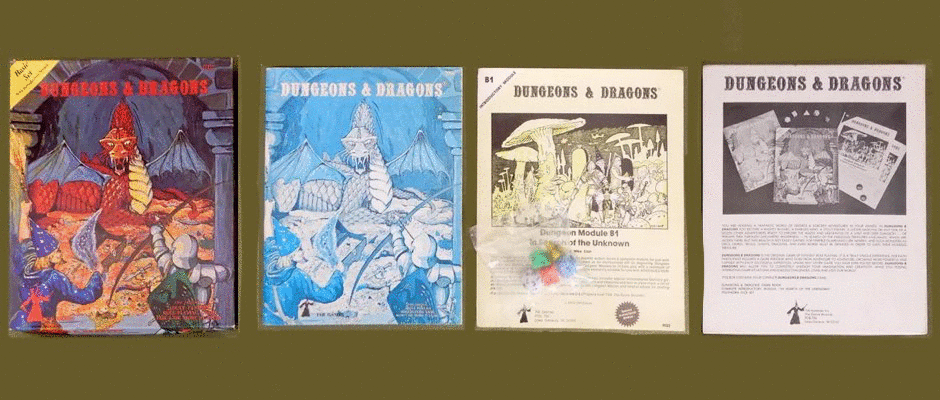
On the surface this is Pathfinder‘s take on D&D’s 3.5 series called The Complete…and it is, to a limited point.
Similarities:
- Introduction of a new base class, the Magus.
- More Feats.
- More Spells.
Not done by WOTC:
- More variants and archetypes for all classes from Core and Advanced Player Guide (aka APG). Not solely Arcane or Divine users.
- A chapter on mastering magic with subcategories regarding the what, how and why of mastering.
- A whole chapter on “Words of Power.”
- No new Prestige Classes.
Chapter 1 introduces the Magus base class. On the surface it appears to be a compromise those frustrated with multi-classing via the traditional Fighter/Wizard or Fighter/Sorcerer route. For starters, I wish the author(s) came up with a better name. The new class has some significant differences to make it more than two classes mashed up together; but they still have spellbooks (Wizard) with a slower progression (Sorcerer).
- Arcane Pool: this power is equal to the Magus’ INT modifier plus half their class level, minimum of one. Then the Magus can expend one point from the pool to give their weapon a +1 magic enhancement for a minute. As the Magus achieves higher levels, additional magical features can be imbued into the weapon such as flaming, keen, etc and at the cost of those powers; e.g. a +1 flaming sword is two points, one for the +1 and the other one for the flaming element.
- Spell Combat: they fare better than Wizards when casting spells while wearing armor, aka the whole somatic argument.
- Spellstrike: extending touch spells’ range through a Magus’ weapon.
- Magus Arcana: more options on using the Arcane Pool with a weapon.
- Spell Recall: something I allow in my campaign for the other casters. Their mechanic is simpler so I will seriously look into this for Wizards, Clerics, etc.
- The rest are improvements of the above resulting in expansion or extension of those powers.
The Magus’ spells are smaller than a Wizard’s but the focus is martial applications of magic which is what most players doing the Fighter/Wizard combo wanted.
Now comes variations for eight Core, five for APG and the Magus. I’ll just list what I liked and will probably use:
- Bards can learn Masterpieces, elaborate performances with certain outcomes.
- Their take on the Cloistered Cleric, Clerics who just staff a temple or the village priestess, aka, Clerics who never go on adventures.
- Druids receive new Domains pertaining to their Nature inclinations.
- For Elric fans, the Magus has an archetype which uses a semi-intelligent “black blade.” A variation with Hexes like a Witch, a ghost blade and a staff instead of a sword as the weapon of choice.
- Monks can take Vows. Following them leads to special ki powers.
- Paladins can take Oaths. Nice yet it makes them too similar to Cavaliers. What the Oath grants, substitutes for core Paladin powers.
- Rangers get a list of traps they excel at setting. More Archetypes too.
- More Bloodlines for Sorcerers.
- More Hexes for Witches.
- Wizards receive Discoveries in addition to the Metal and Wood Schools (these are considered elements in the Oriental world) and an Archetype called the Scrollmaster.
Chapter 2 is about mastering magic through these topics:
- Spellblights: more powerful curses affecting only spell casters.
- Spell Duels: arbitrating two spell casters exclusively utilizing magic to duke it out.
- Binding Outsiders: not just the evil ones.
- Building/Modifying Constructs: they do get damaged and some clever wizards will find ways to make them tougher to destroy. Besides, the Bestiary series never did explain how various golems are made.
- New familiar choices.
- More details on spellbooks. Mainly example ones created by other Wizards.
- Designing spells and more importantly, how to prevent the players from re-inventing the wheel or making a more powerful fireball. We all know that player.
Chapter 3 has the Feats focused on enhancing magic usage and the Archetypes introduced in Chapter 1.
Chapter 4 covers Words of Power. Sounds interesting yet I fear it would bog down my game. The PCs are still in the lower, middling levels and none cast spells anyway.
Chapter 5 are more Spells for the casters to add to their magical arsenals.
There is a pocket version due this Spring but either way, I find UM pretty useful. The bulk of its contents will give the PCs and GMs plenty of new options without bogging down the overall game. Now to find a way to help a player convert his Rogue into a Magus in a credible manner.
